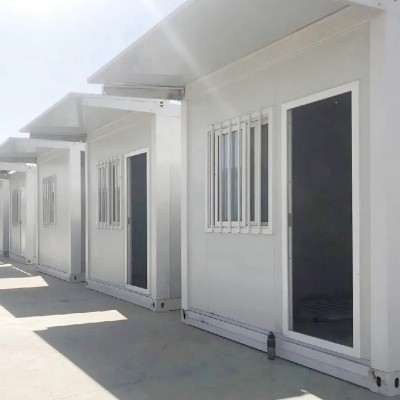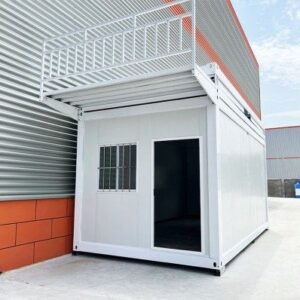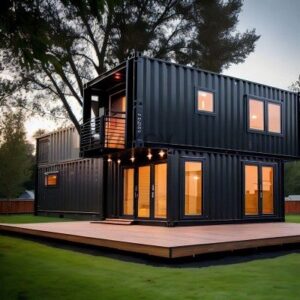Average Price Range of Shipping Container Houses Shipping Container Home Costs Breakdown
When considering how much are shipping container houses, prices vary widely depending on size, finishes, and customization. Here’s a clear look at average costs based on container numbers and build quality.
Price Breakdown by Container Size and Number
| Containers | Size Estimate (sq ft) | Basic Shell Cost | Mid Range Cost | Luxury Custom Cost |
|---|---|---|---|---|
| 1 Container | ~320 sq ft (40ft container) | $10,000 – $25,000 | $40,000 – $60,000 | $75,000+ |
| 2 Containers | ~640 sq ft | $20,000 – $50,000 | $80,000 – $120,000 | $150,000+ |
| 3 Containers | ~960 sq ft | $30,000 – $75,000 | $120,000 – $180,000 | $220,000+ |
- Basic shell models typically mean a used container with minimal modifications, no insulation, and simple finishes. They’re affordable but less comfortable for year-round living.
- Mid range homes include insulation, windows, doors, interior walls, basic plumbing, and electrical. They offer a balance of comfort and cost.
- Luxury or custom container homes feature high-end finishes, advanced insulation, remodeling, premium appliances, and intricate designs. Prices can rival or exceed traditional homes.
Cost Examples of Shipping Container Houses
- A basic 1-container home shell (no HVAC or interiors) could cost as low as $10,000 plus land and permits.
- A mid range 2-container home with standard insulation, kitchen, bathroom, and living space averages $100,000.
- Custom 3-container homes with eco features and designer interiors regularly top $200,000.
Comparing Container Home Costs to Traditional Homes
- Cost per square foot for shipping container homes ranges between $125–$250, depending on the finish level, whereas traditional homes in the U.S. average $150–$300 per sq ft.
- Speed and ease of construction often make container homes more affordable upfront but keep in mind local permit fees and site-specific costs can add up.
- Custom designs and off-grid features in container homes might increase costs but bring long-term savings on utilities and maintenance.
If you’re wondering how much are shipping container houses, you’re not alone—and you’re in the right place. Shipping container homes are shaking up the housing market with their sustainability, affordability, and unique style. But before you dive in, understanding the full price picture is crucial. From container prices to permits, insulation to labor, knowing what drives the cost can save you time, money, and headaches. In this guide, yichen breaks down the real numbers behind shipping container house prices—no fluff, just clear, practical insights to help you budget smart and build the home you want. Let’s get into it!
What Are Shipping Container Houses
Shipping container houses are residential structures built using steel cargo containers, typically repurposed from those used in global shipping. These containers are transformed into livable homes by modifying their interior and exterior to meet building codes and comfort needs. The appeal of shipping container homes lies in their durability, modular design, and eco-friendly reuse of materials.
Unlike traditional homes constructed from wood, brick, or concrete, shipping container houses use the container as the primary structural shell, which can significantly speed up the build process and reduce certain material costs. These homes vary from simple, single-container studios to multi-container complexes designed with customized layouts and finishes.
Shipping container homes are ideal for those interested in affordable housing options, sustainable living, or innovative architectural designs. They offer flexibility in size and style, making them a popular choice for both urban and rural settings. However, the overall shipping container home construction cost depends heavily on factors like container condition, design complexity, insulation, and location.
By understanding what shipping container houses are, you get a clearer picture of why their shipping container house prices can range widely and what influences those costs. This insight is essential when considering container homes as a viable and cost-effective alternative to traditional housing.
Factors Affecting the Cost of Shipping Container Houses
When figuring out how much a shipping container house costs, several key factors come into play. Understanding these can help you plan a realistic budget and avoid surprises down the road.
Container Purchase Price New vs Used
The price varies significantly based on whether you buy new or used containers. New containers cost more upfront but usually need less work and promise better structural integrity. Used containers are cheaper but may require repairs, treatments for rust, or cleaning, which add to your overall costs.
Size and Number of Containers
The number of containers and their size directly impact the price. A one-container home is obviously less expensive than a multi-container setup. Larger or stacked designs require more materials and labor, increasing costs.
Location and Shipping Logistics
Where you live affects your shipping container home budget. Shipping containers must be transported to your build site, and these logistics costs vary by distance, accessibility, and local regulations. Remote or difficult-to-access locations typically mean higher shipping and delivery fees.
Design Complexity and Customization
Simple rectangular container homes cost less than those with complex designs, extensive cutting, or custom features like large windows, doors, and open floor plans. Every cut or modification adds labor and material expenses.
Foundation and Site Preparation Costs
Even though containers are strong and portable, they need proper foundations. Costs depend on soil type, land slope, and foundation type (pier, slab, or crawl space). Site clearing and leveling add to these expenses.
Insulation and Climate Adaptations
Containers are steel boxes, so proper insulation is essential to handle extreme heat or cold, especially in many parts of the U.S. Climate-specific adaptations like HVAC, vapor barriers, and moisture control systems also affect cost.
Labor Costs DIY vs Professional Builders
Doing the work yourself can save money, but professional contractors bring experience that often prevents costly mistakes. Labor costs vary by region and the level of customization—some parts are easier to DIY, others require pros.
Permitting and Legal Fees
Local building codes and permits vary widely and can impact your budget. Some areas require detailed inspections or zoning approvals that add to cost and project time.
Utilities and Infrastructure Electricity Plumbing
Connecting your container home to electricity, water, and sewage is often overlooked but critical. Installing plumbing, wiring, and septic or sewer lines can cost thousands depending on proximity to existing services.
Interior Finishes and Appliances
Finally, the cost includes the interior: walls, flooring, cabinetry, kitchen appliances, and bathrooms. Minimal finishes keep costs down but limit comfort, while high-end fixtures and appliances push the price up considerably.
Understanding these components helps you get a clearer picture of the shipping container home construction cost and what to expect when budgeting your project.

Additional Expenses to Consider for Shipping Container Houses
When planning your shipping container house budget, it’s important to factor in more than just the construction costs. Some additional expenses can significantly impact the overall price.
Transport and Delivery Fees
Moving the containers to your building site isn’t always straightforward. Transport and delivery fees depend on:
- Distance from the container supplier to your location
- Size and number of containers
- Accessibility of your building site
Remote or hard-to-reach areas in the U.S. often incur higher shipping costs. Always ask for detailed delivery quotes early on.
Site Development and Foundation Costs
Before assembly begins, your land may need preparation. This includes:
- Land clearing to remove trees, rocks, or debris
- Foundation work such as concrete slabs, piers, or footings designed to support container homes
Foundation type depends on soil condition and your home design, affecting price. Budgeting both land and foundation prep is key.
Unexpected Repairs and Modifications
Shipping containers are durable but sometimes require repairs or upgrades:
- Fixing rust or dents on used containers
- Cutting and welding for windows, doors, or custom layouts
- Reinforcing the structure based on local building codes
These costs can add up, especially if inspections reveal issues after purchase.
Ongoing Maintenance Costs
Finally, ongoing upkeep plays a role in the long-term cost of a container home:
- Regular painting or rust-proofing to protect the steel
- HVAC system maintenance for proper insulation and comfort
- General wear and tear repairs
Planning ahead for maintenance keeps your home in good shape and prevents bigger repair bills later.
How to Budget for Your Shipping Container House
Creating a realistic shipping container home budget is key to avoiding surprises along the way. Here’s how you can get a solid estimate and stay on track financially.
Tips for Accurate Cost Estimation
- List all major expenses upfront: Include container purchase, site prep, insulation, utilities, permits, and interior finishes. Don’t overlook smaller items like delivery or inspections.
- Get multiple quotes: Whether it’s for container prices, contractors, or materials, getting several estimates helps you understand the market and avoid overpaying.
- Consider your location: Costs vary widely across the U.S. Shipping, labor rates, and permit fees in your area will impact the total shipping container home construction cost.
- Plan your design carefully: Complex customizations add up quickly. Stick to simpler layouts or modular designs to manage expenses.
Importance of Contingency Funds
Set aside at least 10-15% extra of your total budget as a contingency. Unexpected costs pop up often—maybe you need extra foundation work, upgraded insulation, or repairs on a used container. Having this cushion protects you from financial stress mid-build.
Financing Options and Incentives
- Eco-friendly loans and grants: Many states and local governments offer incentives for sustainable building. Look into green building loans or grants geared toward energy-efficient homes.
- Traditional mortgages and construction loans: Some lenders now accept container homes as collateral, but requirements vary. Prepare a detailed budget and plans to improve approval chances.
- Personal loans or crowdfunding: For smaller projects or DIY builds, personal loans or community support can help cover costs without the complexity of formal loans.
By carefully estimating costs, keeping a contingency fund, and exploring financing tailored to shipping container home prices, you can manage your budget confidently and avoid surprises during construction.
Case Studies Real Shipping Container Home Costs
To give you a clear picture of shipping container house prices in the U.S., here are three real examples illustrating how costs can vary based on size, finishes, and location.
1. Basic Single Container Home – Budget Around $25,000
- Setup: 1 used 20-foot container, minimal interior work
- Costs included: Used container purchase, basic foundation, simple insulation, and minimal electrical setup
- Key takeaway: This is the most affordable route but requires significant DIY work and compromises on comfort and finish. Great for tiny home enthusiasts or temporary housing solutions.
- Lessons learned: Budget for unexpected repairs on used containers and simplify design choices to keep costs down.
2. Mid-Range Two Container Home – Budget Around $75,000
- Setup: 2 containers combined, insulated and finished with standard materials
- Costs included: New or lightly used containers, foundation, professional labor, standard electrical and plumbing, moderate interior finishes
- Key takeaway: Provides a comfortable, durable home suitable for year-round living. More expensive but balances cost, quality, and customization well.
- Lessons learned: Plan for labor costs upfront; hiring professionals can save headaches and money in the long run.
3. Luxury Three Container Custom Home – Budget Over $150,000
- Setup: 3+ containers, fully customized design with high-end appliances and finishes
- Costs included: Customized fabrication, premium insulation, HVAC, high-end fixtures, and landscaping
- Key takeaway: Shipping container home prices here approach or even exceed traditional homes, driven by high customization and luxury features.
- Lessons learned: The more intricate the design, the higher continuous costs for maintenance and utilities. Proper planning and realistic budgeting are essential.
Cost Saving Tips for Shipping Container Houses
Building a shipping container house can get pricey, but there are smart ways to keep your shipping container home budget in check without sacrificing quality.
Choose Used Containers Wisely
Buying used shipping containers can save a lot upfront, but be careful. Inspect for rust, damage, and chemical exposure. A cheap container with hidden problems can cost more in repairs later. Opt for containers that are structurally sound, and avoid “one-trip” containers if the price is too good to be true—they often carry hidden wear.
Use Modular Design to Minimize Customization
The more you alter the container’s original shape, the higher your costs. Sticking to a modular design that keeps things simple reduces welding, cutting, and reinforcing expenses. Standard container dimensions should guide your floor plans to minimize custom work and save on both materials and labor.
Weigh DIY Versus Professional Builders
Taking the DIY route can slash labor costs, but only if you have the skills and time. Mistakes might cause costly delays or rework, especially with structure, insulation, and utilities. If you’re unfamiliar with construction, it’s smart to hire professionals for critical steps like electrical and plumbing work while doing simpler tasks yourself.
Utilize Local Materials and Labor
Shipping container homes are already eco-friendly, but keeping your project local cuts costs further. Sourcing local materials—for things like finishes, fixtures, and insulation—not only lowers shipping fees but supports local businesses. Hiring nearby tradespeople also reduces travel expenses and helps you build relationships for future maintenance.
By following these strategies, you can control the cost of building a container home and make your dream affordable without compromising on the quality or comfort of your new space.



